When the stunsail booms are pulled in and lashed is there a set position for them? Is there a spot where they are lashed? How much of the boom should stick out past the end of the yard arm iron? Or does it matter much?
You are using an out of date browser. It may not display this or other websites correctly.
You should upgrade or use an alternative browser.
You should upgrade or use an alternative browser.
i once asked a similar question... how are they pulled in and out. the replies i got said they were done by hand and just lashed in place. to me that makes no sence at all. these booms must weigh hundreds of pounds so working them on a rocking n rolling ship by hand just sounds way to dangerous, fingers n limbs getting crushed or men dragged off their footings or even having the booms just sliding out of control overboard.
some place i once saw there was some rigging for these booms. im trying to find it again since im dealing with this problem again on my flying fish clipper. perhaps just lashing them on the model is good enough, but it would ve interesting to know the actual method.
some place i once saw there was some rigging for these booms. im trying to find it again since im dealing with this problem again on my flying fish clipper. perhaps just lashing them on the model is good enough, but it would ve interesting to know the actual method.
- Joined
- Feb 20, 2022
- Messages
- 197
- Points
- 88

After checking my books, all I could find was info in "Historic Ship Models" & "The Art of Rigging", which both state the stunsail booms were held in place by "boom-irons", metal bands which fit around the main yard, one inboard & one outboard, as a sort of clamp & had a circular band in which the stunsail boom slid through. They were also lashed. The English & French placed them upper diagonally in FRONT of the main yard, the Dutch upper diagonally BEHIND the main yard. I believe the Americans did the same as the English. Hope this helps.
Rick1011
Rick1011
The excellent and very comprehensive book “Seamanship in the age of sail” by John Harland devotes a whole chapter (Chapter 10) to all aspects of studding sails with copious illustrations and details. The entire book is a treasure-trove of information on the whole world of sailing vessels in over 300 pages and I would recommend it without hesitation to any SoS members.
mike, does the book talk about any related rigging for the boom's operation? i cant see these heavy timbers being deployed manually without the help of rigging to prevent human harm. im sure the booms weighed hundreds of pounds, and with sails... sounds rather deadly on a rocking rolling ship at sea so high above the deck besides.
Hi Paul Ron,mike, does the book talk about any related rigging for the boom's operation? i cant see these heavy timbers being deployed manually without the help of rigging to prevent human harm. im sure the booms weighed hundreds of pounds, and with sails... sounds rather deadly on a rocking rolling ship at sea so high above the deck besides.
The book is a very exhaustive study of all aspects of sailing a man-of-war and has lots of data on stuns'ls .....I've tried to take a few photos of some of the relevant pages with my iPad (having just sold my DSLR camera!) whish are attached. I hope they're not too wonky and give you some useful info.
P.S. My son in law (also a Ron), daughter and two girls live in Valley Stream, Nassau County ... small world!
best wishes
Mike
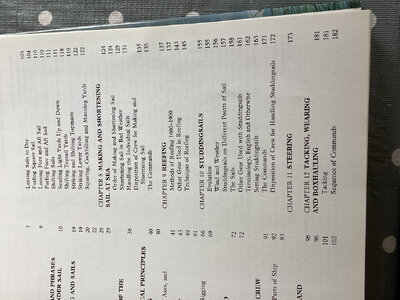
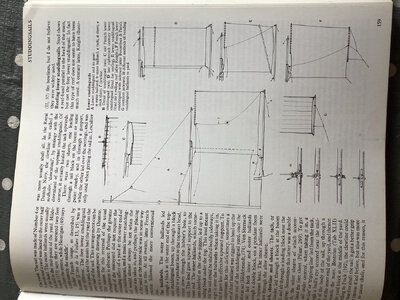
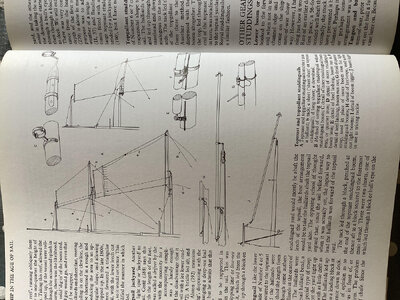
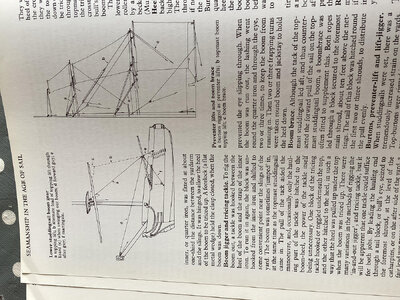
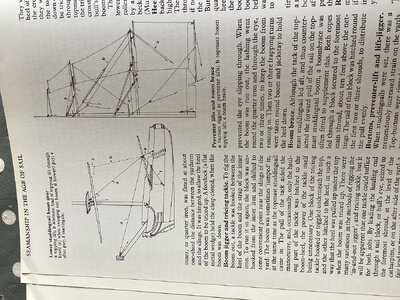
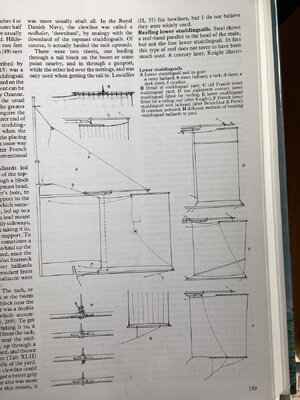
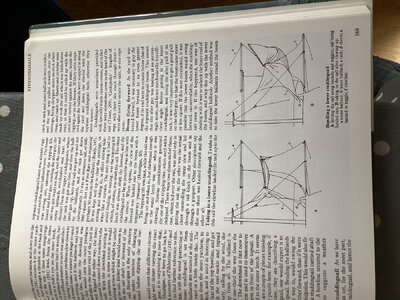
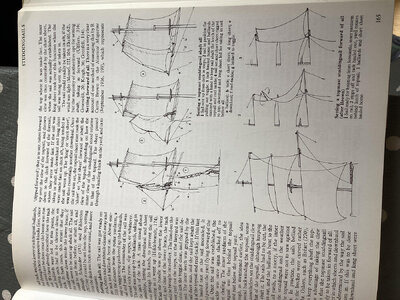
thanks mike. i think i have the book somewhere in the closet. thats quite a complete account of the stunsils. if i dont find my book, ill save your pic n read that... thanks
i think i saw rigging on the booms of the coast guard eagle when it was visiting nyc south street last year. i really didnt pay too much attension to them because i was more concerned with routing sheets n bunts then.
i visit LI every sat... photography friends in merrick. the world has certainly shrunk in my life time. ive got parrots in my pear tree and Chinese lantern flys by the millions. im fighting some strange weeds in my flower beds from another country and we seem to have an abundance of weird fish in our waters too. so yeah the entire world is in everyone's back yard now.
i think i saw rigging on the booms of the coast guard eagle when it was visiting nyc south street last year. i really didnt pay too much attension to them because i was more concerned with routing sheets n bunts then.
i visit LI every sat... photography friends in merrick. the world has certainly shrunk in my life time. ive got parrots in my pear tree and Chinese lantern flys by the millions. im fighting some strange weeds in my flower beds from another country and we seem to have an abundance of weird fish in our waters too. so yeah the entire world is in everyone's back yard now.

The boom dimensions and thus the weight can be calculated using James Lees formulas for the size of the boom. With 15 to 20 men on each side of the main yard standing on foot ropes each would be sharing about 35 to 40 pounds of the load so manually sliding the upper stunsail boom should work. Up to 1810 there was a hole in the inboard end of the boom 1 diameter in from the end. After 1810 there was an eye bolt in each end of the boom. I have no idea how these were used, but perhaps they played a part in sliding the boom out board and back inboard.When the stunsail booms are pulled in and lashed is there a set position for them?
Allan
Last edited:
Kurt Konrath
Kurt Konrath
Not sure much about the rigging to extend or retract the booms, the the two bands work opposite each other on the yard and boom.
The band fitting on end of yard was fixed and the boom slid thru it.
While the band on inboard end of boom was fixed and slide along the yard as it was pulled or pushed in or out.
In one of my rigging drawings I saw a eye ring on the outboard boom band which attached to a eye on the inboard boom band, and a rope fixed from that inboard eye went outboard to pully and then back in to pully on mast, as the other end went from boom end inboard to mast and both went down.
When you pulled on one end it slid the boom out, and when pulling the other end the boom slid back in.
The band fitting on end of yard was fixed and the boom slid thru it.
While the band on inboard end of boom was fixed and slide along the yard as it was pulled or pushed in or out.
In one of my rigging drawings I saw a eye ring on the outboard boom band which attached to a eye on the inboard boom band, and a rope fixed from that inboard eye went outboard to pully and then back in to pully on mast, as the other end went from boom end inboard to mast and both went down.
When you pulled on one end it slid the boom out, and when pulling the other end the boom slid back in.
This is a new one for me. I see no way for the iron to slide along the yard as there are the robands, assorted blocks and stirrups. Could you please share your contemporary sources on this? Lees gives the following explanation on page 14 of The Masting and Rigging of English Ships of War with both the hoops fixed to the yard, not to the boom itself. Four irons were required, one on each end of the yard arm and the others one third of the length of the stunsail booms in from the ends. The inner ones after 1773 were made so that the part to take the boon was able to be opened. The outboard irons were fitted on the yard ends with straps and bolts. He shows drawings of the irons where in there are holes for nails in the inner irons to secure the iron to the yard, not the boom. Anderson gives a similar explanation on page 60 in The Rigging of Ships in the Days of the Spritsail Topmast. Antscherl gives similar description on page 93 in The Fully Framed ModelWhile the band on inboard end of boom was fixed and slide along the yard as it was pulled or pushed in or out.
Volume IV.
Allan




